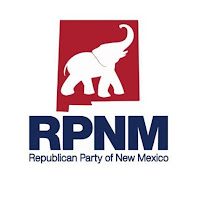As of November 1 the Secretary of State reports there are now five counties that have more independent voters than Republicans, including the two largest of the 33 counties.
--In Dona Ana County, the second largest by voter registration, Independents--or "Decline to State" as the SOS categorizes them--Republicans have 26.1 percent of the registered voters while Independents have 27.8.
--In Santa Fe County, the third largest by registration, the independents outdo the GOP 20.9 percent to 15.0.
--In McKinley County, with its large number of Native American voters, the GOP has shrunk to 16.5 of the registered while the Indys are at 23.6 percent.
--In Los Alamos the Republicans are inched out by Independent voters 28.2 to 28.1 percent.
--In Rio Arriba County the GOP could soon see its sixth county where they rank third in registration. As of November 1 the GOP had 14.9 of the registered voters in that northern Democratic stronghold compared to 14.8 percent Independents.
It's not only the R's who are bleeding support to the Independent column. Not that long ago 49 percent pf the voters in the state were registered Democrats. Today that is down to 43.8 percent. The Republicans have 31.1 percent statewide; Independents are at 23.1 percent and other parties achieve one percent of the registered.
STARK FUTURE?
The numbers are stark for the GOP and another reason the minority party has no prominent statewide elected officials.
With such a large Democratic base in large counties like Dona Ana, Santa Fe and ABQ it has become exceedingly difficult for the GOP to win even if they do well with Independents.
(In big Bernco Dems are at 46.9 of the registered, the GOP at 27.6 percent and Indys at 23.5 percent.)
The old GOP showed it was capable of overcoming a deficit by fielding candidates that appealed to many Democrats as they did in 2010 and 2014 in helping to elect Republican Susana Martinez as Governor. Since then the state has grown increasingly Blue and the GOP needs a new formula to repeat that history. What is that formula? That is one of the deeper mysteries of La Politica.
VOTER BEHAVIOR
It's not only party affiliation that has undergone major changes in the state in the last decade. So has the way voters cast their ballots. Voting before Election Day by absentee and at in-person locations almost always exceeds 50 percent and sometimes goes over 60. Voters like the convenience. In the Nov. 7 New Mexico election a majority of voters again opted to go early but not by much:
Ballots cast in-person on Election Day were neck-and-neck with early and absentee ballots.. . 51% of New Mexicans came in person on Election Day to cast their ballots and another 49% did it during early voting or via absentee ballots. . . Out of the 250,657 people who voted, 122,106 New Mexicans voted early or with absentee ballots. . . A total of 33,619 absentee ballots (were) cast in the election, according to the Secretary of State.
Another 88,487 went to a poll to vote early.
That’s compared to the 128,551 people who voted in person during Election Day on Tuesday.
FIRST BLACK
 |
| Councilor Brown |
Rogers would be the first elected Black to serve on the council since its inception in 1974. However, she would not be the first Black to serve. That honor goes to Dr. Solomon Brown. He was appointed by Mayor Harry Kinney to fill a vacancy in District 3 in 1977. Brown did not seek election to the seat and served just four months.
So if Rogers wins the District 6 seat next month she would become the first elected Black city councilor in modern ABQ history.
THE BOTTOM LINES
Talk about getting stuck on something. On Monday we again referred to new ABQ City Councilor-elect Joaquin Baca as Joaquin Romero. That was not the first time we conjured up former state Sen. Richard Romero whose senate district included much of the council district. Sorry about that but we may have a possible fix. How about just Councilor Joaquin?
This is the home of New Mexico politics.
E-mail your news and comments. (newsguy@yahoo.com)



